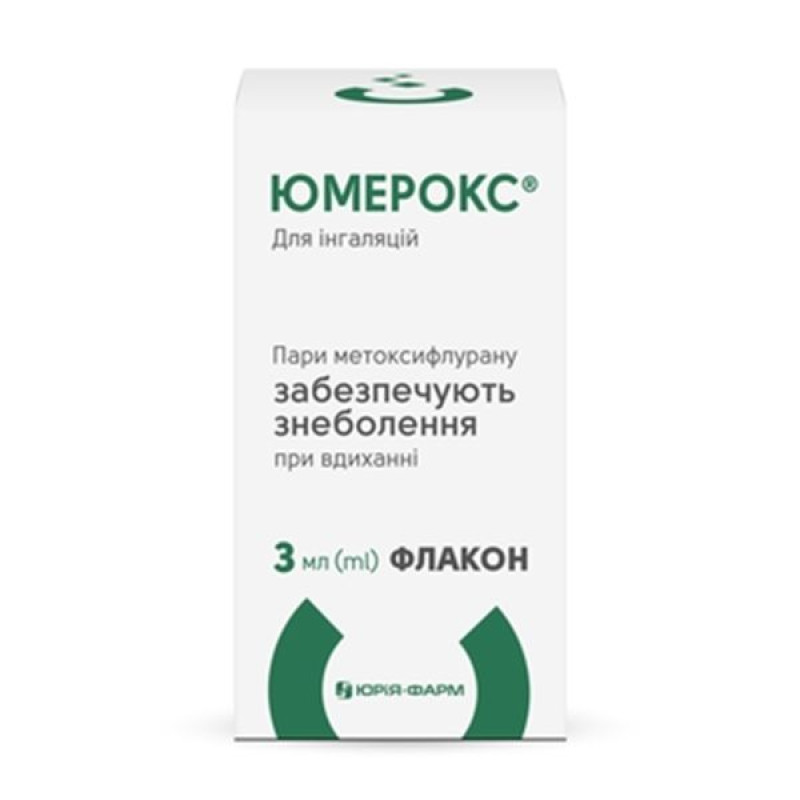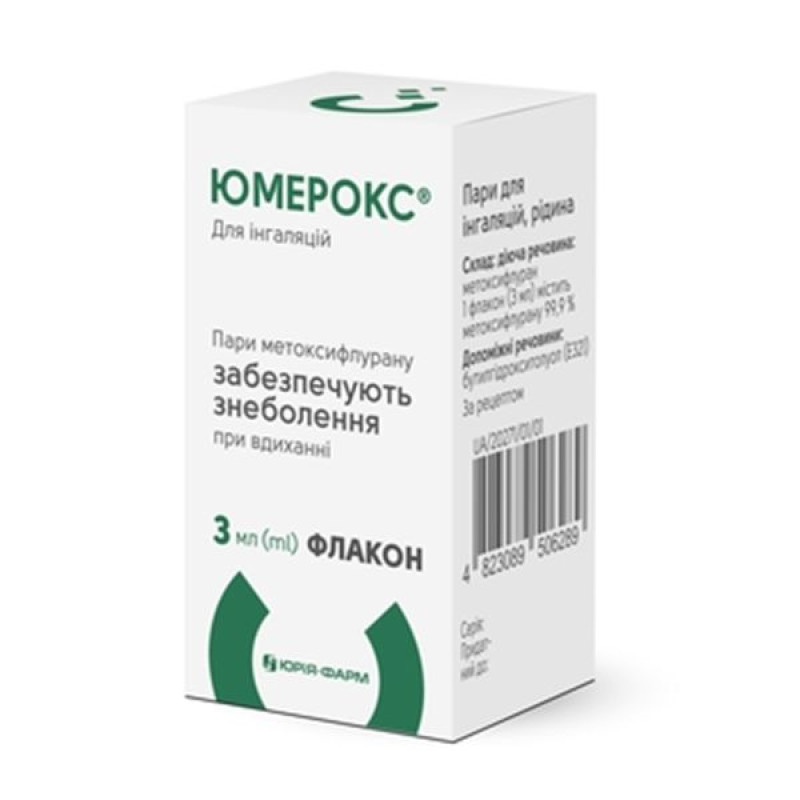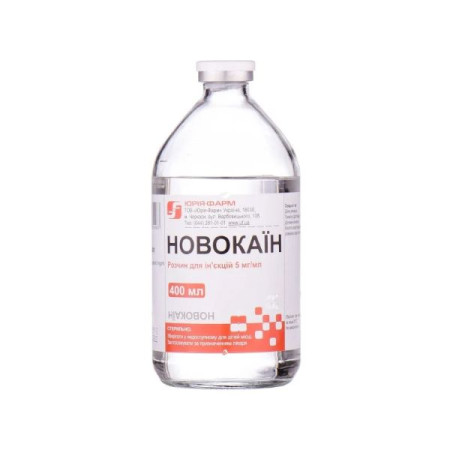Yumerox vapor for inhalation liquid 3 ml bottle No. 1

Instructions for use Yumerox vapor for inhalation liquid 3 ml bottle No. 1
Composition
active ingredient: methoxyflurane;
1 vial (3 ml) contains methoxyflurane 99.9%;
excipient: butylhydroxytoluene (E 321).
Dosage form
Vapor for inhalation, liquid.
Main physicochemical properties: clear colorless liquid with a sweet fruity odor.
Pharmacotherapeutic group
Analgesics. Other analgesics and antipyretics. Methoxyflurane. ATX code N02B G09.
Pharmacological properties
Pharmacodynamics.
Mechanism of action
Methoxyflurane belongs to the group of fluorinated hydrocarbon volatile anesthetics. It is a volatile liquid intended for vaporization and inhalation administration using a methoxyflurane inhalation device.
Methoxyflurane vapor provides analgesia when inhaled at low concentrations. Drowsiness may occur after administration of methoxyflurane. The heart rate is usually regular during administration of methoxyflurane. There is minimal increase in myocardial sensitivity to adrenaline after administration of methoxyflurane. At the superficial level of analgesia, some decrease in blood pressure is possible. This may be accompanied by bradycardia. The observed hypotension is accompanied by a decrease in cardiac contractility and a decrease in cardiac output.
Clinical trials
Data is missing.
Pharmacokinetics.
Distribution
Methoxyflurane is more extensively metabolized than other halogenated methyl esters and has a greater tendency to diffuse into adipose tissue. Consequently, methoxyflurane is slowly released from this depot and becomes available for biotransformation over many days.
Metabolism
Methoxyflurane is biotransformed in humans. Approximately 50–70% of the absorbed dose is metabolized to free fluoride, oxalic acid, difluoromethoxyacetic acid, and dichloroacetic acid. Both free fluoride and oxalic acid can cause kidney damage at high doses, but the dose-dependent nephrotoxicity observed at clinical doses appears to be due to the combination of free fluoride and dichloroacetic acid.
Breeding
Approximately 20% of absorbed methoxyflurane is excreted in exhaled air, while urinary excretion of organic fluorine, fluoride, and oxalic acid accounts for approximately 30% of the absorbed methoxyflurane excretion. Studies have shown that higher peak blood fluoride levels are reached earlier in obese than in non-obese subjects and in elderly patients.
Indication
1. For emergency pain relief in hemodynamically stable, conscious trauma patients with associated pain, by self-administration under the supervision of personnel trained in the use of this medicinal product (see section “Method of administration and dosage”).
2. For pain relief in conscious patients who are under supervision and require analgesia during surgical procedures, such as dressing changes (see section "Method of administration and dosage").
Note: Do not exceed the total maximum dose.
Contraindication
- Use as an anesthetic.
- Impaired renal function, including decreased glomerular filtration rate (GFR), diuresis, and renal blood flow.
- Kidney failure.
- Hypersensitivity to fluorinated anesthetics or any ingredients of the drug Yumerox®.
- Cardiovascular instability.
- Respiratory depression.
- Head injury or loss of consciousness.
- Possible adverse reactions in the patient's history or family history.
- Malignant hyperthermia: patients with known malignant hyperthermia or with a genetic predisposition to it.
Interaction with other medicinal products and other types of interactions
Concomitant use of tetracycline and methoxyflurane for anesthesia has been reported to cause fatal renal toxicity. There is a possibility that methoxyflurane may potentiate the undesirable renal toxicity of other drugs, including certain antibiotics with known nephrotoxic potential, such as gentamicin, kanamycin, colistin, polymyxin B, cephaloridine, and amphotericin B. The dose for subsequent administration of narcotics may need to be reduced.
Concomitant use of Yumerox® with central nervous system (CNS) depressants such as opioids may result in additive depressant effects. If opioids are administered concomitantly with Yumerox®, the patient should be closely monitored, as is standard clinical practice with opioids.
Enzyme inducers (such as barbiturates, alcohol, isoniazid, phenobarbital or rifampicin) that accelerate the metabolism of methoxyflurane may increase its potential toxicity, therefore, concomitant use of these agents with methoxyflurane should be avoided.
Intravenous adrenaline or noradrenaline should be administered with caution during the use of methoxyflurane.
Interaction with β-blockers may be associated with an increased risk of hypotension.
Application features
Liver dysfunction
It is not recommended to administer methoxyflurane to patients who have evidence of liver damage, especially after previous anesthesia with methoxyflurane or halothane.
There have also been isolated reports of liver dysfunction, jaundice, and fatal hepatic necrosis associated with the use of methoxyflurane.
Kidney dysfunction
Due to the effect of released fluorine on the distal tubules, methoxyflurane causes renal dysfunction in a dose-dependent manner and can cause polyuric or oliguric renal failure, the main sign of which is oxaluria.
Due to its potential nephrotoxic effects, methoxyflurane should not be used as an anesthetic. The risk is related to the total dose (time and concentration) and frequency of use.
Methoxyflurane causes renal dysfunction in a dose-dependent manner.
The nephrotoxicity of methoxyflurane is higher than that of other halogenated anesthetics due to slower metabolism over several days, resulting in prolonged formation of fluoride ions and metabolism to other potentially nephrotoxic substances. Therefore, the lowest effective dose of methoxyflurane should be administered, especially in elderly or obese patients.
Due to its nephrotoxic potential, daily use of methoxyflurane is not recommended.
Patients with diabetes
Patients with diabetes who have impaired renal function or polyuria, are obese, or have not achieved optimal control of their condition may be at increased risk of developing nephropathy.
Elderly patients
Due to possible decrease in blood pressure or heart rate, it should be used with caution in elderly patients.
Neurotoxicity in children
Some published studies in children have reported cognitive deficits after repeated or prolonged exposure to anesthetics at an early age. These studies have significant limitations, and it is unclear whether the observed effects are due to the use of the anesthetic/analgesic/sedation agent or to other factors such as surgery or underlying disease.
Published animal studies of some anesthetic/analgesic/sedation agents have reported adverse effects on brain development early in life and late in pregnancy. The clinical relevance of these nonclinical findings has not yet been established.
When such agents are inhaled or infused, the effect lasts longer than the period of inhalation or infusion. Depending on the characteristics of the agent and the patient, as well as the dose used, the elimination phase may be prolonged relative to the period of administration.
Butylhydroxytoluene
Yumerox® contains the excipient butylhydroxytoluene (E 321), which acts as a stabilizer. Butylhydroxytoluene may cause local skin reactions (e.g. contact dermatitis) or irritation of the eyes and mucous membranes.
Work-related impact
Healthcare professionals who regularly come into contact with patients using methoxyflurane inhalation devices should follow appropriate occupational health and safety guidelines when using inhalation devices. Consideration should be given to using methods to reduce exposure to methoxyflurane in the workplace, including the use of an activated carbon (AC) filter. Multiple use poses additional risk. Increased levels of liver enzymes, blood urea nitrogen, and serum uric acid have been observed in exposed maternity ward workers.
Impact on laboratory test results
Data is missing.
Use during pregnancy or breastfeeding.
Fertility
Data is missing.
Pregnancy
Published animal studies of some anesthetic/analgesic/sedation agents have reported adverse effects on brain development early in life and late in pregnancy.
Published studies in pregnant and immature animals have shown that the use of anesthetics/analgesics/sedation agents that block NMDA receptors and/or potentiate gamma-aminobutyric acid (GABA) activity during periods of rapid brain growth or synaptogenesis can result in neuronal and oligodendrocyte cell loss in the developing brain and alterations in synaptic morphology and neurogenesis when administered for longer than 3 hours. These studies used different classes of anesthetics.
All general anesthetics cross the placenta and can cause CNS and respiratory depression in the newborn. In standard practice, this dose is not a problem, but for fetuses with abnormalities, the possibility of such depression should be considered, and the anesthetic agents, appropriate doses, and methods should be carefully selected.
In newborns whose mothers received methoxyflurane for analgesia during labor, a transient increase in serum uric acid levels was observed, which did not require further intervention.
Toxemia of pregnancy
Due to the possibility of renal impairment, the use of methoxyflurane is not recommended.
Breast-feeding
Caution should be exercised when administering methoxyflurane to a nursing mother.
The decision as to when patients can return to activities requiring maximum concentration, operating hazardous machinery or driving a vehicle depends on the individual patient. Patients should be advised to exercise extreme caution as pedestrians and not to drive or operate machinery until the effects of the medicinal product, such as drowsiness, have completely disappeared. The decision to resume such activities as driving a vehicle or operating machinery is at the discretion of the physician.
Method of administration and doses
FOR USE ONLY AS A PAIN RELIEF (SEE CONTRAINDICATIONS SECTION).
Dosage
One vial of 3 ml of the drug Yumerox® is vaporized using a device for inhalation of methoxyflurane.
After the first vial is used, a second one can be used. Up to 6 ml of the drug can be used per day. Changing the vial should be done in a well-ventilated area to reduce the impact of methoxyflurane vapors on the environment.
For maximum safety, the lowest effective dose of methoxyflurane should be used for anesthesia, especially in children and the elderly.
The total dose for a patient during a week should not exceed 15 ml.
It is not recommended to use the medicine for several days in a row.
The cumulative dose received by patients using intermittent doses of methoxyflurane during painful procedures (such as wound dressing) should be carefully monitored to ensure that the recommended dose of methoxyflurane is not exceeded.
Exceeding the recommended dose of methoxyflurane may cause renal failure. Renal failure caused by methoxyflurane is usually irreversible.
Method of application
Yumerox® should be administered independently under the supervision (and assistance if necessary) of a person who is skilled in its use via a methoxyflurane inhalation device.
Children.
Use in children 6 years of age and older. Data on the use of methoxyflurane using a methoxyflurane inhalation device are limited. The lowest effective dose for analgesia should be used in children.
Overdose
Adverse reactions include reactions related to anesthetic doses (see section "Adverse reactions").
After administration of methoxyflurane, patients should be observed for symptoms such as drowsiness, pallor, and muscle relaxation.
In case of excessive diuresis after overdose, fluid and electrolyte losses should be corrected immediately.
Side effects
There is no data on the dose-dependent nature of most adverse drug reactions.
Use of methoxyflurane in patients with trauma and associated pain
The table below describes treatment-emergent adverse reactions that occurred in ≥ 1% of the safety population in a placebo-controlled study in patients with trauma and associated pain.
Adverse events that occurred during treatment in > 1% of the safety population are listed by system organ class and preferred term.
| Gastrointestinal disorders | Dry mouth, nausea, toothache, vomiting |
| General disorders and administration site conditions | Flu-like symptoms, feeling drunk |
| Infections and infestations | Influenza, nasopharyngitis, viral infection |
| Injuries, poisonings and procedural complications | Fall, sprain |
| Research | Alanine aminotransferase (ALT) increased, aspartate aminotransferase (AST) increased, blood lactate dehydrogenase increased |
| Musculoskeletal and connective tissue disorders | Back pain |
| Neurological disorders | Amnesia, dizziness, dysarthria, headache, migraine, drowsiness |
| Reproductive system and mammary gland disorders | Dysmenorrhea |
| Respiratory, thoracic and mediastinal disorders | Cough, oropharyngeal pain |
| Changes in the skin and subcutaneous tissue | Rash |
| Vascular disorders | Arterial hypotension |
The following list contains adverse reactions (treatment-related side effects) that occurred at a lower frequency than in the table above. They are listed by system organ class and frequency [common (≥ 1/100 to < 1/10), uncommon (≥ 1/1,000 to < 1/100) and rare (≥ 1/10,000 to < 1/1,000)].
Neurological disorders
Uncommon: dysgeusia, paraesthesia.
Gastrointestinal disorders
Uncommon: oral discomfort.
General disorders and administration site conditions
Uncommon: fatigue, malaise, feeling of relaxation, hangover, hunger, chills.
Visual impairment
Uncommon: diplopia.
Mental disorders
Uncommon: inappropriate affect.
Use of methoxyflurane in patients requiring anesthesia during surgical procedures
The table below describes drug-related events that occurred in ≥ 2% of the safety population in a placebo-controlled study of patients requiring minor surgical procedures.
| Side effects 30–45 minutes after the procedure | Dizziness, euphoria, nausea, excessive sweating, dysgeusia, facial flushing, hypertension, anxiety, depression, sensory neuropathy, drowsiness/depressed level of consciousness, vomiting |
| Side effects 48 hours after the procedure | Nausea, drowsiness/depressed level of consciousness, confusion, anxiety, vomiting, musculoskeletal and connective tissue disorders |
Reporting of suspected adverse reactions
Reporting adverse reactions after the registration of a medicinal product is important. This allows monitoring of the benefit/risk ratio when using this medicinal product. Medical and pharmaceutical professionals, as well as patients or their legal representatives, should report all cases of suspected adverse reactions and lack of efficacy of the medicinal product via the Automated Information System for Pharmacovigilance at the link: https://aisf.dec.gov.ua.
Expiration date
2 years.
Storage conditions
Store at temperatures not exceeding 30 ° C. Store in original packaging and avoid exposure to high temperatures.
Keep out of reach of children.
Incompatibility.
Incompatibility was either not assessed or not identified at the time of registration of this medicinal product.
Packaging
3 ml in glass vials. 1 vial in a cardboard box. 5 vials in a blister pack, 2 blister packs in a cardboard box.
Vacation category
According to the recipe.
Producer
LLC "Yuria-Pharm".
Location of the manufacturer and address of its place of business.
Ukraine, 18030, Cherkasy region, Cherkasy city, Kobzarska st., 108. Tel.: (044) 281-01-01.
There are no reviews for this product.
There are no reviews for this product, be the first to leave your review.
No questions about this product, be the first and ask your question.










